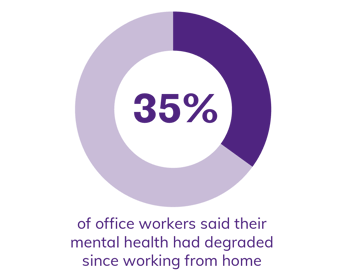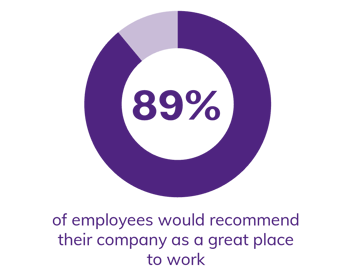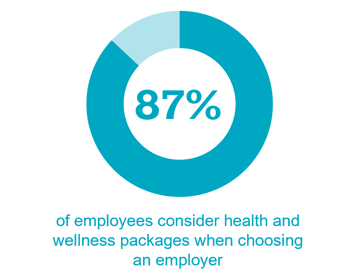According to ACAS, poor mental health is costing £30 billion annually, while working whilst ill and unproductive costs a further £19 million in ‘presenteeism’.
Meanwhile, the World Health Organisation reports that companies with effective wellness programmes increase productivity by 20%, and the mental health charity Mind found that FTSE 100 companies that prioritise health and wellbeing outperform the rest of the FTSE 100 by 10%.
In March 2020, everything changed. For many employees, it was their first experience working from home, and for the first time, employee wellness came to the forefront of workplace culture. The following two years changed the workplace, making hybrid, flexible and fully remote working arrangements a normal part of white collar work.
However, in recent years, the focus has shifted to bringing employees back to the office more consistently, with concerns around wellness and productivity at the forefront. But the importance of wellness at work transcends the remote working debate. While the impacts were transformative in many ways, there are other factors at play, including a notable increase in economic uncertainty and a decline in job security in the years following the pandemic.
One of the main factors to consider in future workplace planning is employee wellbeing. Dr. David Hamilton, our kindness tsar and author of 11 books on wellness, said
“Mental health and wellbeing are being taken more seriously now than at any time I’ve ever known."
That thought rings true for many people in the UK and worldwide.

Here at Talent Insight Group, we strive to improve our wellness culture. We conduct regular surveys to analyse our employees' needs and act on the insights we receive to ensure we create a culture that prioritises our employees.
35% of office workers said their mental health had degraded since the shift to working from home during the pandemic. So, what can you do to put wellbeing at the centre of your organisation? How can you implement a successful wellness programme? What should this look like? How can wellness influence workplace culture?
Want to read this offline or share with a colleague? Simply fill in some details to download a copy.
According to Derren Young, VP - People at Warner Music Group, employee wellness is “the sharp end of HR. It’s more than just structures and numbers; it’s looking after people as humans, which is really the key responsibility for leaders and people in HR.” Workplace wellness allows employees to be their best selves.
Employee wellness is a cornerstone for any successful business. It involves engagement, access to resources, and developing a culture where asking for help is okay and even commended. People spend a huge portion of their lives at work, and according to Vicky Edwards, Chief People Officer at Alfa Financial Software, “if we aren’t able to provide an environment where [people] feel psychologically safe, they aren’t going to thrive or achieve their career aspirations.”
The pandemic highlighted the darker side of employment with anxieties, health problems, lack of support and personal isolation all highlighted as major issues facing the wider workforce. Since then, increasing economic uncertainty has added new challenges, from job security to rising prices. Each of these aspects impacts both employee happiness and productivity. Where an employee feels that they have the tools to succeed, they often do.
But where employees don’t feel they have the tools for success, it isn’t just the individual who suffers. Organisations in this position frequently see high employee turnover and loss of productivity, and innovation, all of which impact the bottom line for organisations.
A workplace wellness programme is not a one-size-fits-all fix. For it to be successful, it requires a tailored solution, input from employees, acknowledgement and responsiveness from senior leadership, and constant vigilance from those implementing the programme. It also requires a library of resources and an understanding of where gaps in service and wellness exist. Senior leadership can bridge this gap by providing a variety of services and resources to ensure employees feel supported.
There is no one answer to what a wellness programme should be. However, our experts agreed that a tailor-made wellness programme is the ideal model for each company. This sentiment was echoed throughout each conversation with our HR and wellbeing experts across the UK.
Companies such as Alfa Financial Software conduct a pulse survey every two months and ensure a two-way communication channel so that people can submit ideas in multiple places. “All of this comes back to culture,” said Vicky Edwards, Alfa's Chief People Officer.
“It’s really interesting when we overlay what we’ve done with our surveys with the activities and initiatives that we take on. It’s a very kind and caring culture with lots of feedback, but it’s always done with the right intent, which is important.”
Derren Young, VP - People at Warner Music Group
When looking at which aspects to cover in a wellness programme, we are guided by our kindness tsar, Dr. David Hamilton, who follows the five components that influence health, as advocated by the British Society of Lifestyle Medicine.
These pillars are:
Each pillar is integral to physical health and well-being, making them a great starting point for developing a workplace wellness programme.
Employee wellness can work wonders for creating a healthy and positive working environment.
“Employee wellness comes from two sides” said Emily Lofting-Kisakye, HR Director for Cognita Schools.
“From the non-commercial business side, it’s important because you want people to live balanced healthy lives and want them to understand what happiness is for them and how they can provide balance to themselves. In the commercial/corporate sense, the better the wellbeing and balance is, the better the productivity; there’s less employee turnover, less cost of hiring – there are real quantifiable benefits [to workplace wellness].”
But really, how does wellness influence culture?
When a company is investing in its people through a wellbeing programme, it absolutely contributes to a stronger brand and better attraction. While it may be easy for a company to mention employee wellness on their website, it’s another thing entirely to put this into practice. Candidates are likely to do their research on a business before applying, so many are now looking on sites such as Glassdoor to understand the lived experience of normal employees.
Every person we interviewed said that wellness has to come from the top. If it’s recognised that senior leadership teams are engaging with, and sign-posting resources, employees are more likely to utilise them.
“You have to mean it” said Derren Young when asked how companies can engrain wellness into their culture. “Only commit to what you can achieve. A company is nothing without its people. If they’re not happy, we’re not a good company.”
Emily Lofting-Kisakye also added a point which cannot be overstated: “Top-down leadership is the most important. If your executives don’t model and lead it, where will it go? Support and resources for direct managers is also important as they are the most connected [to the workforce].”

A study from the American Psychological Association agrees with our experts. It shows that workplace wellness programmes with senior leadership support yielded positive employee outcomes. 89% of employees said they would recommend their company as a great place to work, and 91% said they were more motivated to do their best at work as a result.
At Talent Insight Group, we make mental health and development a priority for our employees and our leadership. We offer free independent support from qualified professionals for our colleagues and model this across our leadership with support from HAÛS. Their philosophy of supporting the whole self aligns perfectly with our approach to talent development. Our Chairman, Glen Hall, has worked with the team first-hand.
Most people are blind to who they are and how they act day-to-day because it's all they have ever known. This isn’t a problem specific to any one person, but one we all face. Becoming curious about how we act and why we act the way we do is the first step in shifting awareness. This awareness can help us change our approach and make us better inside and outside of work. Here are some questions you can ask yourself to help you begin the journey.
True aliveness is not about doing more—it is about being deeply present, aware, and intentional. At Haûs, we hold human beings and encourage them to step into this space, to allow them to uncover who they are being and to create transformation and continuous aliveness. Because when we change from within, everything around us changes too. Continue the journey at hausofchange.com
Natalie Hendricks, Founder, Haûs
As we appreciate the individual and financial benefits of a wellness-focused culture, we wanted to understand what our colleagues needed from us to be happy and productive, both inside and outside of work. So in 2020, we decided to implement a wellness programme of our own, starting with a short anonymous survey.
Questions included:
The most important question, however, was:
We built our wellness programme based on the feedback we received, splitting it into three priorities based on the responses.
The chart below shows the first survey's results, which identified work/life balance, team building, and stress management as the top support requests.

Some of the key outcomes we were able to implement quickly included:
Ensuring we regularly look for new tools, articles, and resources to share with our staff.
Helping to build camaraderie across teams, especially when working remotely.
We continue to run an annual wellness survey to collect feedback and ideas to improve our offering. This has resulted in the addition of additional wellness support, including:
Every TIG employee has access to an accredited counsellor with the British Association for Counselling and Psychotherapy and a life coach who specialises in stress management, resilience and work-life balance. Employees can use these services with the confidence that it’s completely confidential, and all the business will see is an anonymised invoice.
We’re keenly aware of the temptation to work longer hours, but we know this doesn’t support productivity long-term and can cause a disconnect between home and office life. So our team members are encouraged to set a reasonable timeframe to shut off that working brain and take advantage of the time outside of work to relax and recharge. One of the practical ways we support this is through an early finish on a Friday.
Our 2024 survey showed that these changes meant that all our staff felt supported, although there is always room for us to improve. The top three requests for more support were around work/life balance, mental health and a request for more external speakers at team events.
Want to read this offline or share with a colleague? Simply fill in some details to download a copy.
Workplace wellness is not a corporate fad or just a buzzword used to improve brand perception. It is a movement, an all-encompassing solution that brings out the best in your team. It increases happiness, support, and productivity. It has the power to bring people together and positively impact a business culture and bottom line.
Dr. David Hamilton emphasised this: “When people are healthy in their body and mind, they are more productive. They’re more friendly. There’s less absenteeism because people are not off with stress or mental health leave. When people are mentally healthier, we are more creative.”
People are more aware of wellness programmes at work, and are more inclined to join your team if they know they will be supported. Stand by your people, and they will stand by your business.

An article from Forbes highlights this, stating that 87% of employees consider health and wellness packages when choosing and employer. The article also states that more than half of Gen-Zers and Millenials consider company wellness programmes to be important or extremely important when deciding where to work.
Wellness helps in all aspects of business. From recruitment, to retention, attraction, pipelining and productivity, wellness touches on every outlook regarding HR and future talent.
It boils down to this: workplace wellness is here to stay, and if you want a successful wellness programme, let your employees guide the way.
© Talent Insight Group 2025